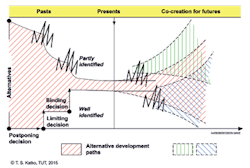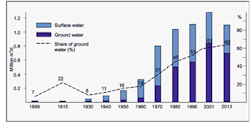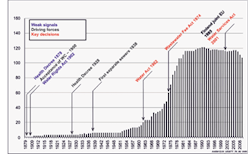Finland's Water Services: Looking to its Past to Figure Out its Future
Nothern Lights: Finland often ranks among the top countries for environmental management
Looking to the past to figure out its future
Finland is often ranked among the top few countries when it comes on water and environmental management yet ageing infrastructure is catching up with the country. This article addresses the long-term development of water and sanitation services in Finland to consider their implications for the future.
By Tapio S. Katko
Water and wastewater services will face huge challenges in the coming decades in Finland. Likely the biggest current challenge of water and wastewater services at least in the developed world is the aging water and wastewater infrastructure.
In the Finnish case, we have signs that aging infrastructure is now rising up the national agenda and in a few cases, additional efforts have been made on rehabilitation. Yet, several studies show that with the current rate of rehabilitation the systems will further deteriorate and two to three times more should be invested in rehabilitation of the systems.
After this challenge, we will explore how water and wastewater systems in Finland have evolved to the current state that, in spite of its challenges, is among the top countries in many water and environment related international comparisons.
Water services evolution
Finland is quite unique regarding its water resources. The country has some 56,000 lakes with a minimum area of one hectare and a total of nearly 190,000 lakes at least 500 square meters in area. Groundwater occurs in alluvial eskers formed during the last ice age.
For geological reasons, areas lower than 50–60 meters above the current Baltic Sea have problems with water quality. In these areas, bigger cities use surface water, acquire their raw water from sources further away and may use artificial recharge.
After World War II, the economic structure changed dramatically in Finland; particularly in the 1960s this change was among the fastest in Europe. Currently, many recent international comparisons on water and environmental management have ranked Finland among the top countries. The comparisons take into account several management and government related criteria – not only the relatively rich amount of water available per capita. These two factors acted as the driving forces and justification for this study.
In this context technology is assessed by the Political, Economic, Social, Technological, Ecological, and Legislative (PESTEL) framework commonly used in Futures Research and Administrative Studies.
Paths and changes
In Finland the share of groundwater and artificial recharge in community water supplies has increased continuously from the 1930s. In the early part of the 20th century, the relative share of groundwater decreased after many cities turned to surface water sources (Fig. 2). In 1970 the share of groundwater use was 31 percent, and by 1980 already 45 percent. In 2015 the estimated joint share of ground water and artificial recharge was 65 percent of community water supply.
After the introduction of the Wastewater Fee Act in 1974 and the Act on Public Waterworks and Sewerage Systems in 1977, specific water use started to decline. The maximum average value was 340 liters per capita per day. Since then it has declined by one-third. Due to overdesign this decline has, however, made it possible to expand the systems and renovate pipes by no-dig methods, although being also a strain on the income of utilities. At the same time the challenges of water quality have partly transferred to the networks.
Fig. 3 elaborates the development of water pollution control and urban wastewater treatment in Finland from 1879 to 2009. The first weak signals of coming water pollution control were the Health Decree of 1879 and the Water Rights Act of 1902. The major driving forces for pollution control comprised of the acceptance of flush toilets around 1900, the Health Decree of 1928, the construction of the first separate sewers in 1938, and EU membership in 1995.
The key decisions with concrete requirements for wastewater treatment were based on three specific acts: Water Act of 1962, Wastewater Fee Act 1974, and the Water Services Act of 2001. Besides, the Water and Wastewater Utilities Act of 1977 strongly promoted the integration of water and wastewater utilities.
The key lesson of water pollution control – proper legislation, enforcement and control has also implications for the current aging infrastructure. Analogically, better rules of the games will be required to tackle the problem.
Selected strategic decisions and approaches
Since the raw water of Helsinki was known to be soft, experiments were carried out in 1880 on the use of lead pipes. They showed that lead dissolved into the water and thereby their use was avoided. Other Finnish cities followed the principle. This decision was very far-sighted since the replacement of lead pipes is still a challenge in many European and North American cities. In Helsinki, the first Finnish urban water and sewerage system started operating in 1876 as a private concession, the only one in Finnish water services history. It was, however, soon bought back by the city that started to develop its own systems. A private concession was suggested also in Tampere but rejected. In fact, the Local Government Act of 1875 created the basis for developing municipal water and sewage works.
In Finland, as in many other countries, public–private collaboration has been practiced in water services since the early days. The share of water services, goods and equipment bought from the private sector has been particularly high in the early days and during better economic times but quite low during periods of war. In international discussion this major form of public-private cooperation has largely been left unrecognised while the public-private partnership has been questionably used to promote concession and long-term lease contracts only.
In Finland water services are governed at four inter-related levels: (i) on–site systems; (ii) water cooperatives and open partnerships; (iii) municipal utilities in cities and townships; and (iv) supra-municipal systems of various kinds. This diversity is one of the strengths of Finnish water services and their governance, although for the second category we have the challenge of long-term continuity.
In the development of these systems all these options should be considered in each case. Yet, it has to be noted that any organisational form as such can hardly solve the biggest challenges of water services: very low investment in rehabilitation, and far too little input in R&D.
In international cooperation we can see interesting phases. We have the early networking of experts between Finland and especially Sweden and Germany as well as Denmark, France, United Kingdom and the US.
After WWII, a new boom of internationalisation started including education of Finnish experts abroad as well as gradual start of export activities and development cooperation. In the 1990s, European integration and changes in East Europe promoted protection of the Baltic Sea, in which wastewater management was a key issue.
In addition to multilateral activities, bilateral development cooperation projects have been conducted in Tanzania, Sri Lanka, Kenya, Vietnam, Egypt, Mozambique, Nepal, Namibia, Ethiopia, the West Bank and the Gaza Strip, Bosnia and Herzegovina, Kosovo, South Sudan, and Somalia.
Key findings
One study included reflections from seven invited international experts. The Brazilian expert pointed out the need for adaptive capacity such as practised in Finland. The over abstraction and contamination of water resources in India present a huge challenge. In Japan, the total population has already started to decrease: in some local communities it will decrease by half by 2050. In the Netherlands certain historical traditions are still valid.
Although the Dutch institutional framework may seem fragmented, they probably contribute to smooth and sensible coordination of the various actors. In the US, the greatest challenge is ageing infrastructure. In Ukraine, appropriate technology has been applied in wastewater treatment adapted to local resources within available financial resources. On the whole, some similarities or principles that are potentially applicable in water services are found all over the world.
Firstly, appropriate pricing is a sound basis for any development but varies according to conditions. Secondly, we need sound institutional arrangements where the roles of various partners support each other. Thirdly, the principles of good governance, including fighting corruption, should be introduced. Finally, the need for long-term thinking in water services is necessary for any viability and resilience. Finally, proper management of the systems is eagerly pursued.
As for exceptionally interesting issues in international contextFin the following developments from Finland are suggested for further exploration:
(i) Integration of water and wastewater utilities in urban areas except for supra-municipal systems;
(ii) A special wastewater fee act to speed up water pollution control
(iii) Demand-based and consumer-managed cooperatives in rural areas
(iv) Various kinds of organizations for water services from on-site systems to cooperatives, urban utilities, and several forms of supra-municipal entities
(v) The principle of continuous and dynamic development instead of ad hoc reforms that have produced good results.
In spite of many differences Finland and many developing economies seem to have more common and analogous challenges and development needs than perhaps sometimes remembered. That is also a good argument in favor of increased cooperation and sharing knowledge between north and south, east and west for promoting global well-being.
Now that community water supply and especially water pollution control seems to be largely solved, at least regarding point sources, it is time to put more emphasis on rehabilitation of the aging water services infrastructure, especially networks, in Finland and worldwide.
Fig. 1 Strategic decision-making and path-dependence of pasts and presents and co-creation for futures.
Fig. 2. Changes in relative shares of surface and groundwater use for community water supplies in Finland, 1899–2013.
Fig. 3. Total number of urban wastewater treatment plants in 1910–2009, number located in the 102 cities in existence in 1994, and related key legislation.
Tapio S. Katko is an adjunct professor, UNESCO Chairholder in Sustainable Water Services at the Tampere University of Technology, Finland. This article is based on a book by Katko: Finnish Water Services – Experiences in Global Perspective. Finnish Water.




